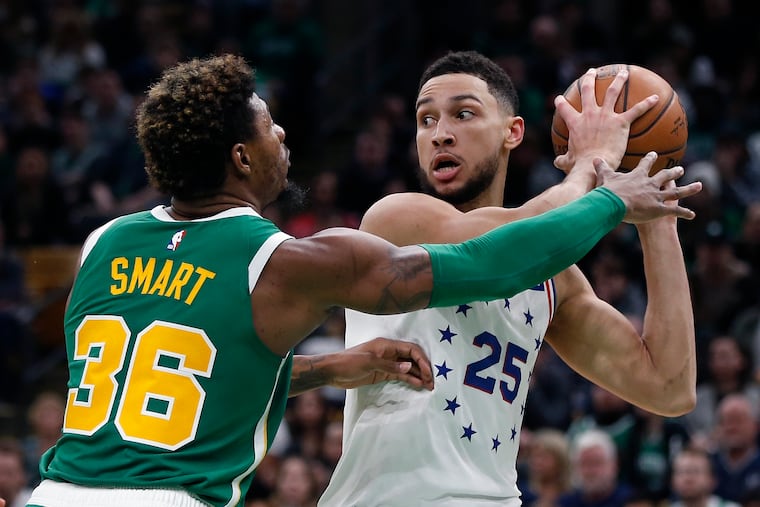Ben Simmons and Joel Embiid don’t fit yet, but you can’t rush time | David Murphy
There is a path to coexistence between Embiid and Simmons, and, given Simmons' makeup, you’d be a fool to rule it out.

Of all Ben Simmons' preternatural abilities, the most unusual might be his self-awareness. That’s saying a lot, because he is a player who checks off an awful lot of physical boxes, with a combination of length and speed that is among the best in the NBA and comes packaged with the fluidity and body control more typical among men a fraction of his size. Yet, all of these things can be found in various doses elsewhere. The psychological component, on the other hand, is one of those you-have-it-or-you-don’t characteristics that today’s athlete increasingly seems to lack.
Simmons has it -- or, rather, It -- and that’s an important thing to keep in mind whenever the discussions turn toward the various things he lacks at this stage of his career. There are many ways the NBA’s reigning Rookie of the Year falls short of the ideal player, but to define him as the player he isn’t is to miss out on one of the more enjoyable stages of the development of a star. Right now, the important point isn’t whether he is great or not great, it’s whether he cares, and whether he harbors within himself a proportional understanding of the difference between the two. On both counts, Simmons passes the test.
“He wants to be great,” veteran JJ Redick observed recently.
Just as important, Simmons knows what that means, and it is something to consider in the wake of another performance in which his fledgling skill set seemed under-equipped for basketball’s biggest stage.
In a 121-114 overtime loss to the Boston Celtics at TD Garden on Christmas Day, the Sixers again looked like a team that is built around a couple of core components that will always operate with some degree of friction. Perhaps that was the true source of the postgame discontent expressed by the other half of their homegrown core. While one could have interpreted Joel Embiid’s comments about his underutilization in the fourth quarter as a shot at the head coach, there’s a possibility that their true genesis lay in a foundation of frustration at having to share the court with a player whose skill set overlaps with his own.
Simmons and Embiid are different players, but their differences exist in an upside-down way. The score sheet says that Simmons is a point guard, but he makes his living almost exclusively in the paint, a place where the laws of geometry and physics suggest that there is room for only one. According to NBA.com, Simmons ranks 10th in the league at 12.6 points per game in the paint, with only one-dimensional big men ranked above him (such as Houston’s Clint Capela, the Lakers' JaVale McGee, and Cleveland’s Tristan Thompson). Embiid, meanwhile, is a big man with enough dimensions that the Sixers' optimal course of action is often to rely on him to create space. Yet, in pulling him and his defender away from the basket, they also limit what should be his most dominant characteristic. That is, he is simply bigger than any man who can conceivably guard him.
Embiid’s inherent physical advantage is one that he is increasingly adept at exploiting. He showed this throughout the first three quarters in the loss to the Celtics, abusing Al Horford in the low and high posts in a way that he was not yet capable of a calendar year ago. Embiid’s increasingly polished post game is the sort of thing that can offer the Sixers the same sort of tide-turning individual dominance that the Celtics received from Kyrie Irving. But, it is also the sort of thing that requires a specific mix of players to maximize. If you were to customize a team that results in an optimal Embiid, it would feature four other players capable of knocking down shots from the corners and above the break -- one ballhandler and two wing defenders with a third capable of guarding the four.
If you were to design the perfect team around Simmons, it would probably swap out one of the three-and-D wings for a combo guard with a high-usage rate, and Embiid for a five man who is clearly the lowest man on the offensive totem pole.
There is a path to coexistence, and, given Simmons' makeup, you’d be a fool to rule it out. He has already made strides. They are subtle, but they are strides. He is a better finisher. He is more assertive in the half court. He clearly spent the summer concentrating on his shooting form. Watch him shoot in the gym, and you’ll see that the flared elbow that wreaked havoc on the physics of the shot is closer to 90 degrees. In game situations, it is not there yet. But it is clear that he knows where it needs to be.
In the meantime, it is clear that he understands the percentages of the game: that, most possessions, the team’s probabilities are highest when he is not shooting outside the paint. On a lesser team, he might feel more freedom to grow his game. Many players wouldn’t care. You’d rather have the current situation than the alternative. As it stands now, the Sixers are closer than any young team deserves to be.
That said, they are not there yet. This latest loss showed that. The challenge for all of them -- Brett Brown and Embiid, most of all -- is navigating the in-between.